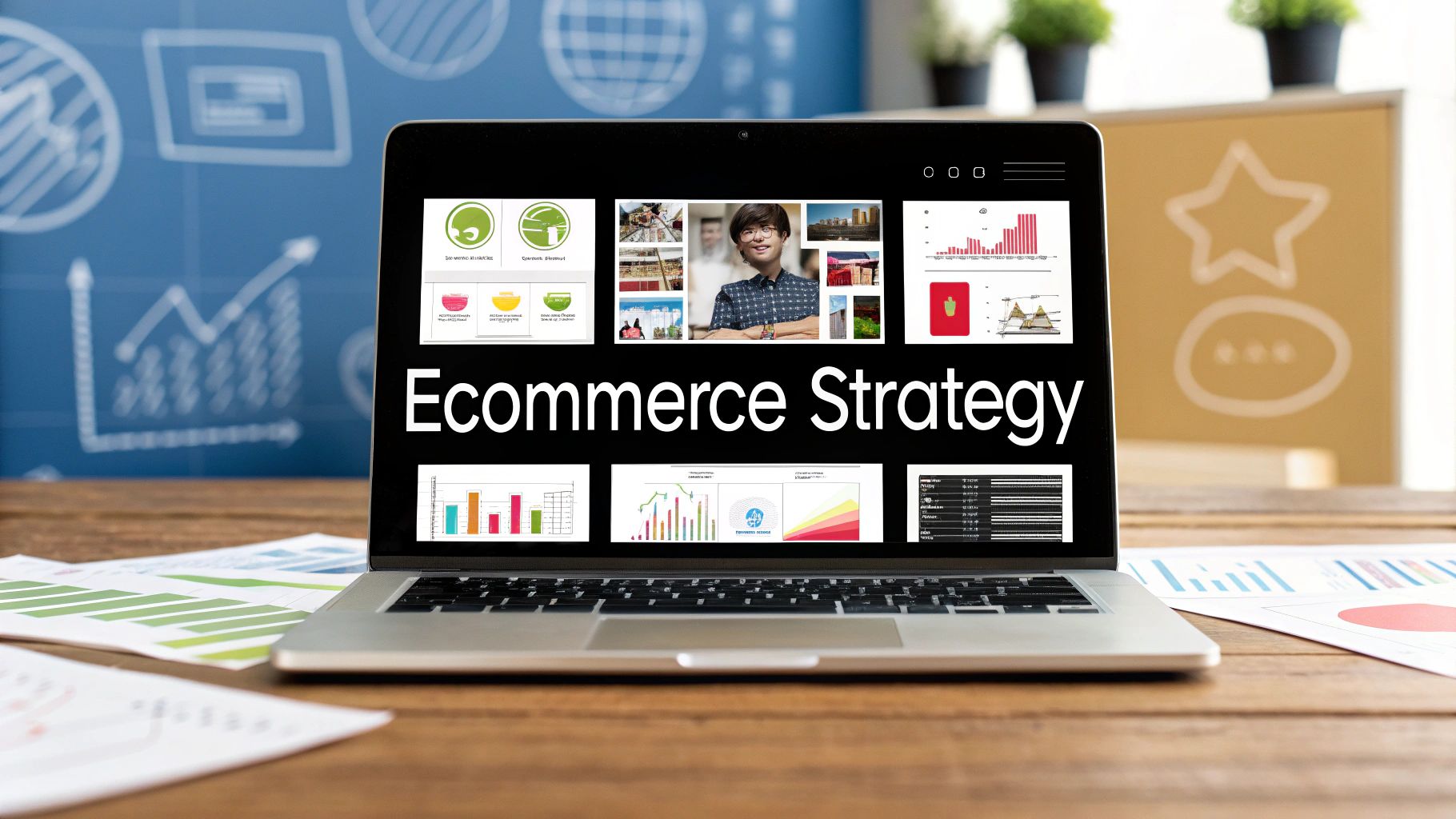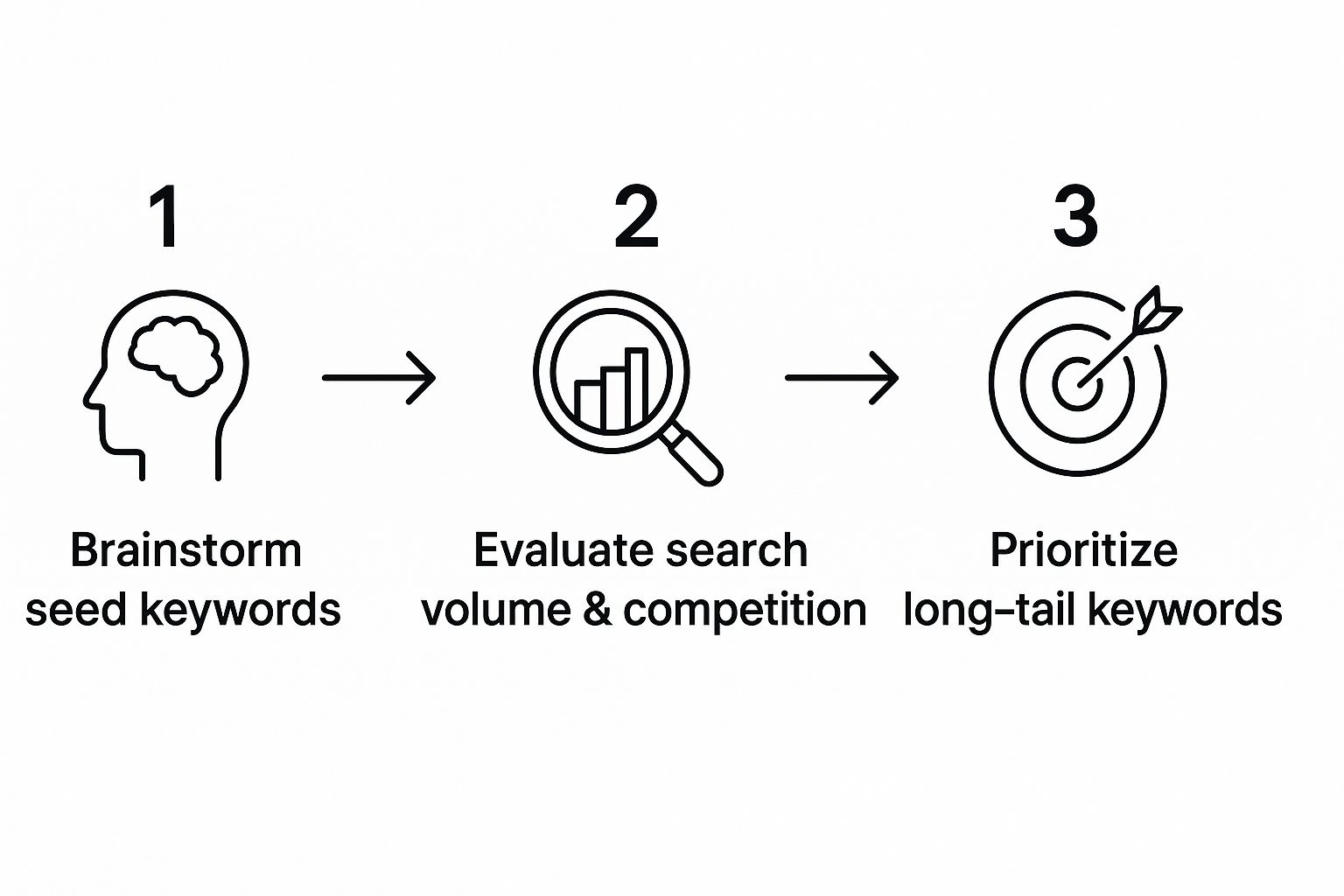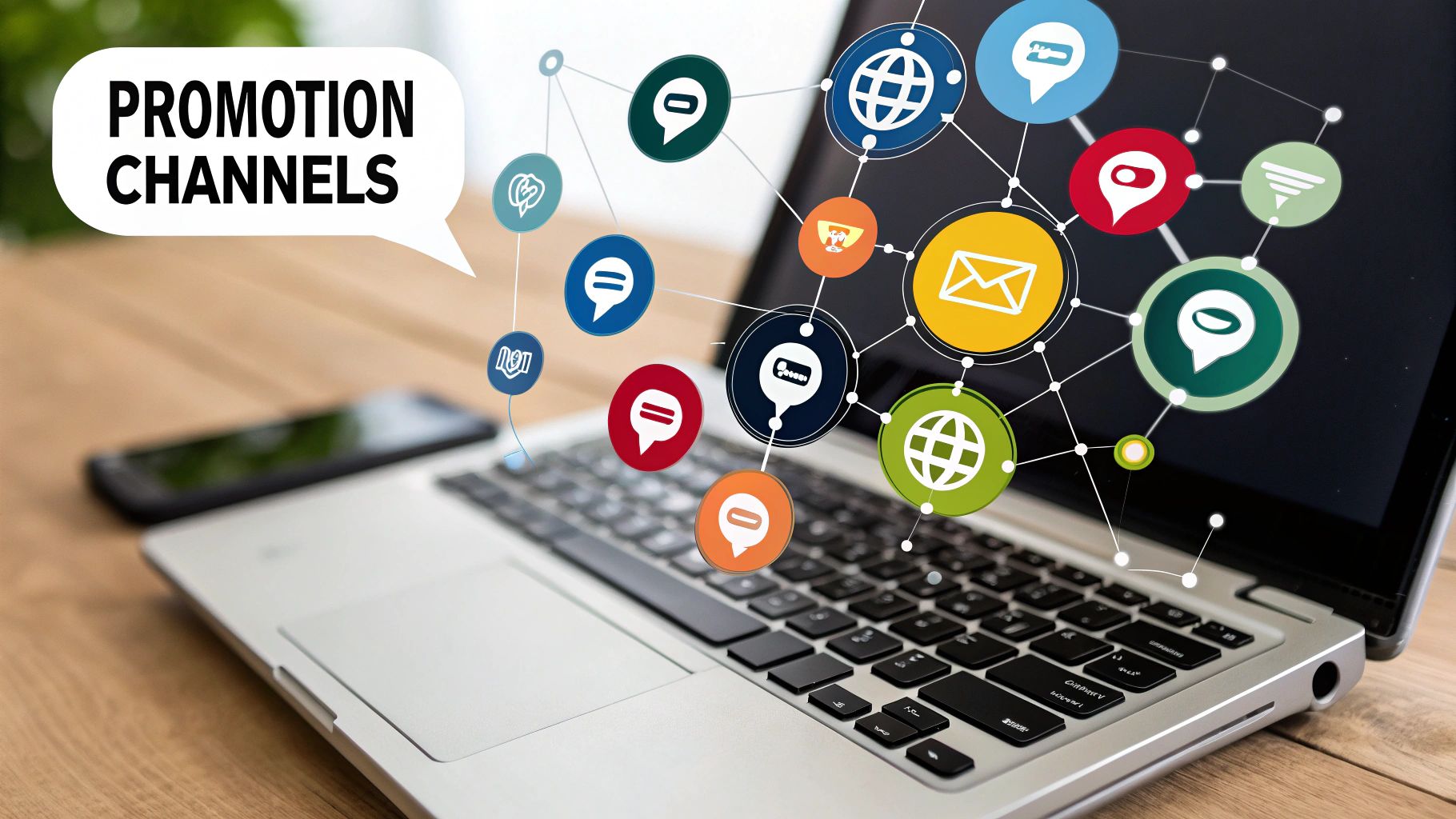
Your Guide to Ecommerce Content Strategy
Build a winning ecommerce content strategy that drives sales. Learn to create content that attracts, engages, and converts customers at every stage.
Here’s the rewritten section, designed to sound completely human-written and natural, following your provided style and requirements.
An ecommerce content strategy is your master plan for creating and distributing content that actually brings in customers. It's the blueprint that turns random clicks into loyal fans and, most importantly, sales. Think of it as the difference between a cluttered flea market and a well-designed boutique—one is confusing, the other guides you straight to what you need.
What Is an Ecommerce Content Strategy?
Imagine your online store is a physical shop. Without a plan, you've just got a room full of products. A smart content strategy is what adds the helpful signage, the knowledgeable salesperson, and the attractive product displays. It's everything working together to create an experience, not just a transaction.
This is how you move beyond just listing items for sale. You're building a system that answers questions, builds trust, and walks a shopper from their first "I'm just looking" visit all the way to checkout. It's about building a relationship.
Why a Cohesive Strategy Matters More Than Ever
Let's be honest: random acts of content don't work anymore. An occasional blog post here or a social media update there won't move the needle. To see real growth, every piece of content needs a job to do, and that job has to connect back to your business goals.
The data tells the same story. Content marketing isn't just a "nice-to-have" for brand awareness; it's a core part of the sales engine. In fact, over 41% of marketers now measure its success by the revenue it generates. And it works—businesses with a solid content plan can see up to 6 times higher conversion rates than those who just rely on ads. If you want to dig deeper, you can explore how these content marketing statistics directly impact revenue.
A great ecommerce content strategy doesn't just sell a product; it solves a customer's problem. It anticipates their questions, eases their doubts, and makes your brand the most logical and trustworthy choice.
The real power here is meeting customers exactly where they are.
- For brand new visitors: Your content provides quick answers and makes a great first impression.
- For returning shoppers: It offers deeper insights that help them feel confident about their purchase.
- For your loyal customers: It reminds them why they chose you and keeps them coming back.
When you put a structured plan in place, your content stops being an expense and starts becoming a high-performing asset—a reliable system that brings in the right people and turns them into repeat buyers.
Crafting Your Core Content Pillars

Now that you’ve sorted out the "why" behind your content strategy, it's time to build the "what." This is where you map out the core content pillars that will prop up your entire customer journey.
Think of these pillars as the main departments in your digital store. Each one is built to attract, engage, and convert visitors in a unique way. These aren't just random pieces of content thrown at the wall; they're strategic assets. Each has a specific job, whether it's drawing in new people with a helpful blog post or sealing the deal with a persuasive product page.
Let's break down the four most essential pillars every successful ecommerce brand needs.
SEO-Driven Blog Posts: Your Top-of-Funnel Magnet
Blog posts are often the first handshake your brand has with a potential customer. Their main job is to pull in organic traffic by answering the exact questions your ideal audience is typing into Google. This is your top-of-funnel workhorse, designed to solve problems first and sell products second.
For instance, a company selling high-end blenders doesn't just write about their specific models. Instead, they create articles like "10 High-Protein Smoothie Recipes for Post-Workout Fuel" or "How to Pick a Blender That Won't Wake Up the Whole House." This builds authority and trust long before someone is even thinking about buying.
For your blog posts to work, they have to be:
- Problem-Focused: Tackle a real pain point or question your customer is struggling with.
- Keyword-Optimized: Build each post around a target keyword to show up on search engines.
- Genuinely Helpful: Provide real value that leaves the reader feeling smarter and more capable. That's how they'll remember you.
High-Converting Product Pages: Your Digital Salespeople
If blog posts are your greeters, product pages are your closers. It’s their job to turn curious visitors into paying customers. A great product page is so much more than a description and a price tag; it's your best salesperson, on duty 24/7. It needs to be persuasive, informative, and compelling enough to get that "Add to Cart" click.
A truly effective product page doesn't just list features; it sells benefits. Instead of saying "10,000 mAh battery," it says "All-day power so you never miss a moment." This shift in perspective is crucial for connecting with customer needs.
Your product pages should be a careful mix of a few key things: stunning images and videos, detailed descriptions that answer questions before they're asked, clear specs, and—most importantly—social proof. Following these guidelines is one of the most important content marketing best practices for driving sales.
Engaging Videos and Unboxing Experiences
Video builds a type of connection that text and images just can't match. It lets you show your product in action, making its value tangible and creating a real sense of desire. It’s no surprise that shoppers are far more likely to buy a product after they’ve seen a video of it.
Think about these powerful video formats:
- Tutorials and How-Tos: Show customers how to get the most out of what you sell. This helps with sales and boosts satisfaction after the purchase.
- Unboxing Videos: These tap into excitement and anticipation, giving customers a preview of the premium experience waiting for them.
- Lifestyle Videos: Place your product in real-world situations your audience relates to. This helps them picture it in their own lives.
User-Generated Content: The Ultimate Social Proof
Finally, the most convincing content pillar often comes straight from your customers. User-generated content (UGC)—like reviews, testimonials, and customer photos—is pure, authentic social proof that builds incredible trust. Study after study confirms it: over 90% of consumers trust what other people say over brand advertising.
Make it a priority to encourage and feature UGC everywhere. Put customer reviews front and center on product pages, create a gallery of customer photos on your homepage, and share user posts on social media. This gives you a never-ending stream of authentic content and builds a powerful community around your brand, turning happy customers into your best advocates.
Mapping Content to the Customer Journey
Making great content is only one part of the equation. For your ecommerce content strategy to really work, you have to deliver the right message at the right moment.
Think of it like a sharp retail associate. They know just when to greet a customer, when to offer help, and when to give them space. That’s exactly what you’re doing here—mapping your content to the customer journey.
Your goal is to guide shoppers from their first flicker of interest to the final click of the “buy” button. When you match specific content to each stage of their buying process, you build trust, smooth out the experience, and make your brand the obvious choice. This turns a random website visit into a clear path to purchase.
The Awareness Stage: What They Need Now
At the top of the funnel, people aren't looking for your product yet. They're looking for answers. They have a problem or a question, and they're turning to Google for help. Your job isn't to sell; it's to be helpful.
Content for this stage needs to be educational, informative, and focused on solving their problem.
For instance, a company selling high-end coffee beans shouldn’t lead with a hard sell. Instead, they pull in potential customers with content like:
- How-To Guides: "How to Make the Perfect Pour-Over Coffee at Home"
- Informational Blog Posts: "The Difference Between Arabica and Robusta Beans"
- Engaging Quizzes: "What's Your Ideal Coffee Profile?"
This kind of content establishes you as a knowledgeable expert. You're giving them value upfront, which builds brand recognition and goodwill long before they're even thinking about buying.
The Consideration Stage: Helping Them Choose
Once a customer understands their need and the types of solutions out there, they move into the consideration stage. Now, they're actively comparing their options, weighing the pros and cons, and trying to find the best fit. Your content needs to shift from broad education to specific guidance.
This is your chance to help them narrow down the field and show them why your products are the better choice. The content here should be more detailed, comparative, and focused on providing a clear solution.
The Consideration Stage is your opportunity to become the most helpful resource in your niche. By providing transparent, detailed comparisons and expert insights, you build the confidence a shopper needs to move forward.
This infographic shows a simple three-step process for finding the right keywords for this stage, making sure your guides and comparisons get in front of shoppers who are actively researching.

The big takeaway? By targeting specific, long-tail keywords, you can create content that perfectly matches the detailed questions people ask when they're in comparison mode.
Content for this stage looks like:
- Detailed Buyer’s Guides: "The Ultimate Guide to Choosing an Espresso Machine"
- Comparison Posts: "Burr Grinder vs. Blade Grinder: Which is Right for You?"
- Product Demo Videos: A video showing exactly how a product works and highlighting its key benefits in action.
The Decision Stage: Closing the Deal
Finally, at the decision stage, the customer is ready to pull the trigger. They’ve done their homework and have probably narrowed it down to just a few brands, including yours. Your content now needs to give them that final nudge of confidence to complete the purchase. The focus shifts to reinforcement, trust signals, and clearing up any last-minute doubts.
This is where social proof becomes your secret weapon. Data shows that over 90% of consumers trust recommendations from peers more than they trust ads from a brand. Showcasing the positive experiences of your past customers is crucial. Your content should answer one final question: "Why should I buy from you?"
The best content to seal the deal includes:
- Customer Testimonials & Reviews: Displaying real reviews right on your product pages.
- Case Studies: Showing how your product solved a real problem for a specific customer.
- User-Generated Content (UGC): Featuring photos and videos from happy customers using your products in their everyday lives.
- Clear FAQs: Answering common questions about shipping, returns, and warranties before they even have to ask.
By thoughtfully mapping your content across these three stages, you create a seamless and persuasive experience that doesn't just attract traffic—it builds relationships and, ultimately, drives sales.
Winning with Mobile and Social Commerce

The modern customer’s shopping journey doesn’t start on a desktop anymore. It happens in the palm of their hand, mid-scroll, where attention is the only currency that matters. If your content strategy isn't built for mobile phones and social media feeds first, you're already behind.
This isn't just a passing trend; it's a fundamental rewiring of how people buy. Mobile commerce now accounts for a staggering 59% of total eCommerce sales, which translates to a mind-blowing $4.01 trillion. On top of that, social commerce is on track to hit $1.2 trillion, proving these aren't just channels—they're entire economies. This shift requires a whole new playbook. Think short-form video, influencer shout-outs, and real-time conversations. You can dig deeper into these numbers with some comprehensive ecommerce statistics on DesignRush.com.
Your content's new job is to stop a thumb. That's it. This means you need to create visual, punchy, and instantly engaging formats that deliver their message in seconds, not minutes.
Creating Content for the Small Screen
Optimizing for mobile is about so much more than a responsive website. It’s a total shift in how you present information. Long, dense paragraphs might fly on a desktop, but they are a death sentence on a phone. Your content has to be scannable. Immediately.
The key is to think in terms of "snackable" content. Break up those product descriptions. Use bold headings, bullet points, and icons to guide the eye. Use high-quality, vertical images and videos that fill the screen on platforms like Instagram Reels and TikTok. Every single element should be designed for a quick glance.
For instance, instead of a long-winded paragraph about a jacket's technical specs, a mobile-first approach gets right to the point:
- 100% Waterproof: Laugh at the rain.
- Breathable Fabric: All-day comfort, no sweat.
- 7 Secure Pockets: Keep your stuff safe and easy to grab.
This format instantly tells the customer what they need to know, respecting their time and the reality of how they browse.
The goal of mobile content isn't just to inform; it's to make the path to purchase completely frictionless. If a customer has to pinch, zoom, or squint to get the details, you've already lost them.
Turning Social Feeds into Sales Channels
Social commerce has turned platforms like Instagram, TikTok, and Facebook from places to share photos into powerful, integrated storefronts. A killer ecommerce content strategy doesn't just market on social media—it sells directly through it, letting customers buy without ever leaving the app.
This is where shoppable posts are a game-changer. When you tag products in your images and videos, you build a direct bridge from "I love that!" to "It's mine!" A user sees your post, taps to see the price, and can check out in a couple of clicks. It's seamless, and it demolishes purchase friction.
Visual storytelling is what ties it all together. The brands crushing it on social use a mix of content to build that "I need it now" feeling:
- Behind-the-Scenes Videos: Showing how your products are made creates a real, authentic connection.
- Influencer Partnerships: Getting your products in the hands of creators their audience already trusts is pure gold.
- User-Generated Content (UGC): Sharing photos and videos from your actual customers is the most powerful social proof there is. It's far more convincing than any ad you could ever run.
By tailoring your content for mobile and social, you’re meeting customers exactly where they hang out. You make it effortless for them to discover, want, and buy your products, turning your content from a simple marketing tool into a powerful engine for growth.
Using AI to Scale Your Content Creation
How do you create more high-quality content without burning out your team? For a lot of growing ecommerce brands, the answer is artificial intelligence.
Think of AI less like a robot that replaces your writers and more like a super-powered assistant. It’s brilliant at handling the repetitive, time-consuming tasks, which frees up your team to focus on the big picture—strategy, creativity, and nailing your brand voice.
The truth is, using AI in your content strategy isn't some futuristic idea anymore. It's quickly becoming the new standard. Over 80% of marketers already use AI tools for generating, tweaking, and personalizing their content. Why the shift? Because in a crowded market, you need an edge. AI lets you create tailored content at a scale that just wasn't possible before. For more on this, check out these AI-powered content marketing statistics on Typeface.ai.
This is where AI really shines. It can give a small, nimble team the output of a much larger one.
Practical AI Applications for Ecommerce
Forget the idea of AI as a magic button that spits out perfect content. Instead, think about where it can have the most impact. AI is incredible at generating structured drafts and tons of variations, which you can then polish with your unique brand perspective.
It’s all about working smarter.
Here are a few real-world ways you can put it to use:
- Product Descriptions: Instead of writing one description, use AI to create dozens of options. You can ask for different tones (playful vs. professional), formats (bullet points vs. paragraphs), or angles (focusing on benefits, features, or lifestyle).
- Blog Post Outlines: Staring at a blank page? AI can draft a detailed, SEO-friendly outline in seconds. Just give it a target keyword and a topic, and it will structure the entire article with headings and key talking points.
- Email Campaigns: AI can help you write killer subject lines, engaging body copy, and clear calls-to-action for your newsletters. It can even help you personalize campaigns for different customer segments, like first-time buyers or loyal fans.
The real magic of AI is its ability to do the first 80% of the work. It builds the foundation, leaving your team to add the final 20% of creative genius that makes the content uniquely yours.
Balancing Automation with Authenticity
Here’s the most important part: a successful AI workflow always keeps a human in the loop.
AI is a tool. And like any tool, the quality of its output depends entirely on the instructions you give it and the final polish you apply. If you just copy and paste, the content will feel generic and soulless, which can quickly erode the trust you've worked so hard to build.
Your brand’s voice, your stories, and your deep understanding of your customers are your biggest assets. Let AI create the first draft, but always have a human editor review, fact-check, and inject that essential personality. This is a core principle of effective ecommerce marketing automation—making sure efficiency doesn't kill your authenticity.
When you combine AI’s speed with human creativity, you get the best of both worlds: more content, and a real connection with your audience.
How to Measure Your Content ROI

A great ecommerce content strategy feels good, but it also has to deliver real results. If you can’t connect your content directly to your bottom line, you’re basically just flying blind. Measuring your return on investment (ROI) is what transforms content from a creative expense into a predictable growth engine for your business.
This means looking past vanity metrics like page views and social media likes. Sure, those numbers show you have an audience, but they don't tell you if your content is actually making you money. The real goal is to prove how your blog posts, videos, and guides directly contribute to sales and keep customers coming back.
When you track the right things, you can finally justify your marketing budget, double down on what works, and ditch what doesn’t. This data-driven approach is the final, crucial step in building a content strategy that’s not just creative, but truly profitable.
Identifying Your Most Important KPIs
To measure the true impact of your content, you have to link it to Key Performance Indicators (KPIs) that reflect the health of your business. It’s not about tracking everything; it’s about tracking the right things. The most valuable KPIs for ecommerce go way beyond simple traffic numbers.
Think of it this way: traffic is like people walking into your store. Conversions are the people who actually buy something. Both are important, but only one pays the bills. Your focus should be on the metrics that bridge that gap between eyeballs and revenue.
Here are the core KPIs that really matter:
- Conversion Rate: What percentage of people who engage with a piece of content end up buying? This is the ultimate test of how persuasive your content really is.
- Average Order Value (AOV): Do customers who read a detailed buyer’s guide or watch an unboxing video tend to spend more per purchase? This proves your content is successfully upselling or cross-selling.
- Customer Lifetime Value (CLV): Do things like post-purchase tutorials or exclusive email content lead to repeat business? Tracking CLV shows how your content builds long-term loyalty.
- Add-to-Cart Rate: This KPI reveals how well your product pages and related content spark that initial "I want this" moment, even if the visitor doesn't check out right away.
These metrics give you a much clearer picture of your content’s financial impact than surface-level analytics ever could. While tracking these on your site is key, the same logic applies to other channels. You can learn more by checking out our guide on how to measure social media ROI.
Using Attribution to Connect Content to Sales
One of the trickiest parts of measuring content ROI is connecting a blog post someone read on Monday to a sale they made on Friday. This is where attribution modeling comes in. Simply put, attribution is just the process of giving credit to the different marketing touchpoints a customer interacts with on their path to making a purchase.
A customer almost never sees one piece of content and buys instantly. They might find your brand through a blog post, read a comparison guide a week later, and finally click a retargeting ad to buy. Attribution helps you see the role each step played.
Without attribution, you might accidentally give 100% of the credit to that final ad they clicked, completely ignoring the blog post that introduced them to your brand in the first place.
To make this easier, you can match specific KPIs to each stage of your sales funnel. This helps you see how your content is performing at every step of the customer journey.
Matching KPIs to Your Funnel Stage
This table breaks down the most important metrics to track for each stage of the customer journey, helping you measure the true impact of your content.
| Funnel Stage | Primary Goal | Key Metrics to Track | | :--- | :--- | :--- | | Awareness | Attract new visitors and build brand recognition. | Keyword rankings, organic traffic, referral sources, and page impressions. | | Consideration | Help shoppers evaluate their options and build trust. | Time on page, click-through rate (CTR) to product pages, and email sign-ups. | | Decision | Drive sales and remove final purchase barriers. | Conversion rate, add-to-cart rate, and average order value (AOV). |
By matching the right metrics to each stage, you can build a simple but powerful dashboard in a tool like Google Analytics 4. This gives you a complete picture, letting you see which top-of-funnel articles are effectively feeding your bottom-of-funnel product pages.
This knowledge empowers you to invest your resources with confidence, ensuring your ecommerce content strategy is always optimized for maximum growth.
Frequently Asked Questions
Jumping into a full-blown ecommerce content strategy can feel like a big leap. It’s natural for a few questions to pop up. Let's tackle some of the most common ones so you can move forward with confidence.
How Long Until I See Results from Content?
This is the big one, and the honest answer is: it depends. A great ecommerce content strategy is a marathon, not a sprint, and the timeline shifts based on what you’re creating.
For your big, top-of-funnel plays—like SEO-focused blog posts designed to pull in new people—you need a bit of patience. Expect to see real traction in traffic and search rankings within 3 to 6 months. It simply takes time for search engines to find, index, and trust your new content.
But that’s not the whole story. Content aimed at shoppers already on your site can deliver results much, much faster.
- Detailed Product Guides: These can boost conversion rates almost immediately by clearing up confusion and giving shoppers the confidence to buy.
- Targeted Email Offers: A well-timed campaign to your email list can drive sales the same day you hit "send."
- Customer Testimonials: Adding fresh social proof to your product pages can lift add-to-cart rates in a matter of weeks.
The trick is to have content working for you at every stage. That way, you’re building a powerful, long-term organic engine while still capturing sales today.
What Is the Difference Between Content Marketing and Ecommerce Content Strategy?
It’s easy to mix these two up, but there’s a crucial difference in their focus. Think of it like this: content marketing is all your raw building materials—the bricks, lumber, and nails. An ecommerce content strategy is the architect’s blueprint that tells you exactly how to use those materials to build a house that sells.
Content marketing is the what—the act of creating valuable things. An ecommerce content strategy is the why and the how—the specific plan linking every single piece of content to the goal of driving online sales.
While general content marketing might chase broad goals like brand awareness, an ecommerce strategy is relentlessly focused on revenue. Every article, video, and social post has a job to do, guiding a customer from discovery to checkout. Success isn't just measured in likes or views; it's measured in conversion rates, average order value, and cold, hard sales.
How Much Should I Budget for Ecommerce Content?
There’s no magic number here. Your budget depends entirely on your business size, how competitive your industry is, and how fast you want to grow. A scrappy startup might start with pure sweat equity, focusing on killer product descriptions and a niche blog.
As a solid benchmark, many growing businesses allocate 10-15% of their total marketing budget to content. This usually provides enough fuel to create consistent, high-quality content without breaking the bank.
The smartest way to approach it? Start with a budget you’re comfortable with. Track your return on investment like a hawk using the KPIs we covered earlier. Then, double down on what works and scale up your investment strategically. This way, your money is always working to grow your bottom line.
Ready to create, automate, and schedule viral social content that drives real sales? With ViewPrinter, you can build dynamic posts in seconds, create custom avatars, and launch high-converting ads with powerful AI tools. See how ViewPrinter can transform your content workflow.